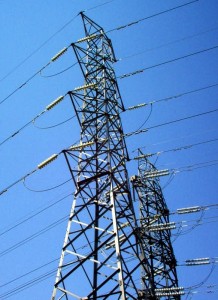The Machine at the Center of the Clean Power Plan
By William Boyd, Ann Carlson and Cara Horowitz
 As attention shifts from last night’s debate to today’s oral argument on the Clean Power Plan, we thought it worth focusing on the machine at the heart of the President’s plan to cut greenhouse gases from the electric power sector: the electricity grid. You might think that the largest machine in the United States is one of West’s hydroelectric dams, or perhaps a huge assembly-line factory or an underground particle accelerator. But instead, it’s our interconnected electricity grid, which connects the dam and the factory and the accelerator to transmission and distribution lines to provide them with power.
As attention shifts from last night’s debate to today’s oral argument on the Clean Power Plan, we thought it worth focusing on the machine at the heart of the President’s plan to cut greenhouse gases from the electric power sector: the electricity grid. You might think that the largest machine in the United States is one of West’s hydroelectric dams, or perhaps a huge assembly-line factory or an underground particle accelerator. But instead, it’s our interconnected electricity grid, which connects the dam and the factory and the accelerator to transmission and distribution lines to provide them with power.
Built over many decades and across thousands of miles, the electricity grid connects even far-flung communities to sources of power such as fossil-fuel-fired power plants, large solar power arrays, wind turbines, and hydropower dams. The grid is an interconnected, real-time network: Whenever someone in Miami charges her iPad, the grid all the way up to Maine feels the drain and responds by drawing ever-so-slightly more electricity from power generators. The grid is energized, in real time, just enough to meet demand and from a variety of interlocking power sources. Grid operators, acting somewhat like orchestra conductors, coordinate generation as needed – taking a little more from one power plant and a little less from another. The result is affordable and reliable energy.
But this machine is also our largest source of climate pollution in the U.S. Generating electricity is responsible for 37 percent of our country’s total carbon dioxide emissions. Most of those emissions come from older coal-fired power plants. Other sources of power, like solar, wind, nuclear, and hydropower, create no climate pollution. Natural gas plants fall somewhere in between. In other words, depending on the precise mix of power sources generating power for the grid that day, the iPad user in Miami contributes a greater or lesser amount to the problem of climate change.
The Clean Power Plan uses the grid’s interconnectedness to reduce power-sector emissions in an efficient, effective way. The Plan would cut carbon dioxide emissions significantly by 2030 – to about a third below 2005 levels. The rule justifies that level of reduction by calculating, among other things, the potential for shifting generation toward low- and zero-emitting sources and away from coal-fired power plants. Yet the coal industry and conservative attorneys general who are challenging the CPP claim that we should ignore the interconnected electricity machine and treat its component parts – power plants – separately.
We represent power grid experts from across the country in the litigation. These experts agree with the Obama Administration that the best way to control climate pollution from existing power plants is to take advantage of the grid’s operation as a giant, interconnected machine. Grid operators are accustomed to shifting among sources of power, so the CPP’s efforts to favor cleaner sources over dirtier ones – for example, solar over coal – makes sense. This sort of generation-shifting respects the way the grid has always worked. It also mimics the approach taken by other air pollution control programs, which have historically prompted power companies to draw more power from cleaner plants and less from dirtier ones.
The challengers assert that our efforts to cut emissions from the power sector should be limited to tinkering with the on-site equipment at individual fossil-fuel plants. Such half measures, however, barely move the needle on climate pollution. More importantly, they work against grid structure, ignoring the interconnected nature of the grid as a coordinated and interlocked machine. As our grid experts concluded, it would make little sense to consider only emissions reductions within the artificial boundaries of individual facilities when all facilities deliver undifferentiated power to unitary grids.
The challengers also say that the CPP would undermine the reliability of the electricity grid. But our experts think that cutting emissions by 30 percent is well within the capacity of the grid and will in no way interfere with the grid’s ability to provide power to its users.
This fight over the CPP is critical. Although the U.S. recently ratified the Paris Agreement, without the CPP it will be hard for the U.S. to fulfill its emissions reduction pledge. Perhaps even more important, if the CPP is struck down, America’s leadership position in getting the global community – including the world’s largest emitter, China – to ratify the Paris Agreement will be seriously undermined.
Grid operators and experts understand that to make meaningful, cost-effective reductions in climate pollution from the power sector, we should work with the grid’s structure, not against it. We should shift electricity generation to cleaner sources of power from dirtier ones and make the country’s largest machine a greener, less polluting one . We hope the federal court in Washington, D.C. listens to their advice.







Reader Comments